高中英语 高二上学期第七次Unit 2 Poems 选修6教案
英语:unit 2《poems》教案-writing(新人教版选修6)
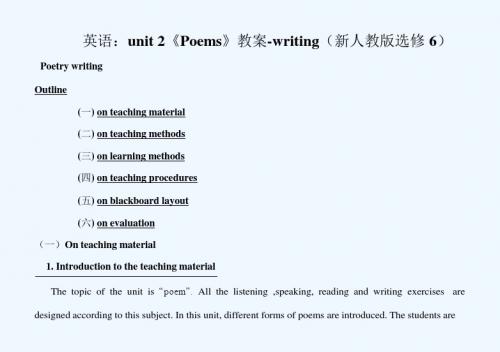
(四)On teaching procedures
Teaching steps
Teacher’s activity
Students’activity
Designing purpose
1. Lead-in
Show the students two Read the two poems and Get the students to poems try to discover the features. discover the features themselves so that it will be easier for them to write.
designed according to this subject. In this unit, different forms of poems are introduced. The students are
required to learn about the features of different forms of poems as well as try to write simple poems and appreciate beautiful literature works. Lessons arrangement Period 1: Warming up & Reading Period 2: Language Points Period 3: Word study &Using language Period 4: Listening Period 5: Grammar teaching Period 6: Writing 2.The function of this lessonin the unit
Unit 2 Poems教学设计(英语人教高中选修6)
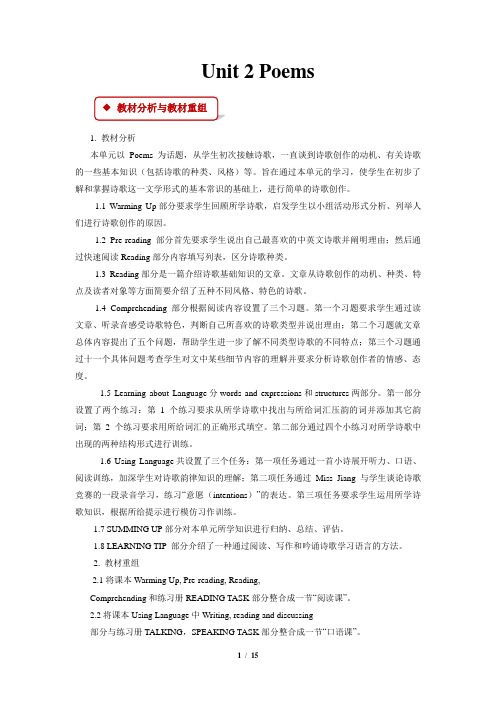
Unit 2 Poems1. 教材分析本单元以Poems为话题,从学生初次接触诗歌,一直谈到诗歌创作的动机、有关诗歌的一些基本知识(包括诗歌的种类、风格)等。
旨在通过本单元的学习,使学生在初步了解和掌握诗歌这一文学形式的基本常识的基础上,进行简单的诗歌创作。
1.1 Warming Up部分要求学生回顾所学诗歌,启发学生以小组活动形式分析、列举人们进行诗歌创作的原因。
1.2 Pre-reading 部分首先要求学生说出自己最喜欢的中英文诗歌并阐明理由;然后通过快速阅读Reading部分内容填写列表,区分诗歌种类。
1.3 Reading部分是一篇介绍诗歌基础知识的文章。
文章从诗歌创作的动机、种类、特点及读者对象等方面简要介绍了五种不同风格、特色的诗歌。
1.4 Comprehending 部分根据阅读内容设置了三个习题。
第一个习题要求学生通过读文章、听录音感受诗歌特色,判断自己所喜欢的诗歌类型并说出理由;第二个习题就文章总体内容提出了五个问题,帮助学生进一步了解不同类型诗歌的不同特点;第三个习题通过十一个具体问题考查学生对文中某些细节内容的理解并要求分析诗歌创作者的情感、态度。
1.5 Learning about Language分words and expressions和structures两部分。
第一部分设置了两个练习:第1个练习要求从所学诗歌中找出与所给词汇压韵的词并添加其它韵词;第2个练习要求用所给词汇的正确形式填空。
第二部分通过四个小练习对所学诗歌中出现的两种结构形式进行训练。
1.6 Using Language共设置了三个任务:第一项任务通过一首小诗展开听力、口语、阅读训练,加深学生对诗歌韵律知识的理解;第二项任务通过Miss Jiang与学生谈论诗歌竞赛的一段录音学习,练习“意愿(intentions)”的表达。
第三项任务要求学生运用所学诗歌知识,根据所给提示进行模仿习作训练。
1.7 SUMMING UP部分对本单元所学知识进行归纳、总结、评估。
高中英语 Unit 2 Poems教案 新人教版选修6
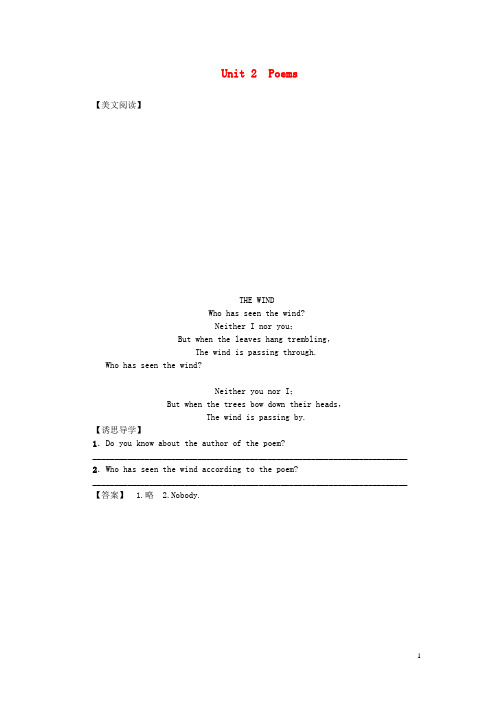
Unit 2 Poems【美文阅读】THE WINDWho has seen the wind?Neither I nor you;But when the leaves hang trembling,The wind is passing through.Who has seen the wind?Neither you nor I;But when the trees bow down their heads,The wind is passing by.【诱思导学】1.Do you know about the author of the poem?________________________________________________________________________ 2.Who has seen the wind according to the poem?________________________________________________________________________ 【答案】 1.略 2.Nobody.Period ⅠPreviewing●教学目标本课时主要是通过学生对学案所给出的内容的学习,了解本课文中所出现的词汇,初步了解课文以及相关的背景知识,对下一堂课课文的全面理解起到一个铺垫作用。
●教学地位本单元话题是“诗歌”。
文中涉及诗歌的韵律、节奏,并介绍了几种不同内容和形式的简单诗歌。
本单元引导学生讨论这些内容,目的在于让他们了解诗歌的一些基本特征和写作方法,自己尝试写简单的诗歌,并学会欣赏这些优美的文学作品。
●新课导入建议可以通过给学生看地图,拼地形图卡片,看幻灯片等,尽可能多的直观地向学生介绍有关英国概况的知识,使学生对当代英国的经济与政治,城市与乡村等诸多方面有一个整体认识。
老师要尽量给学生自主学习的时间和空间,通过自学、自做、自悟、自助等方式,让学生体会和理解文章的内容,探讨英国的文化。
高中英语教学设计选修六unit2poems
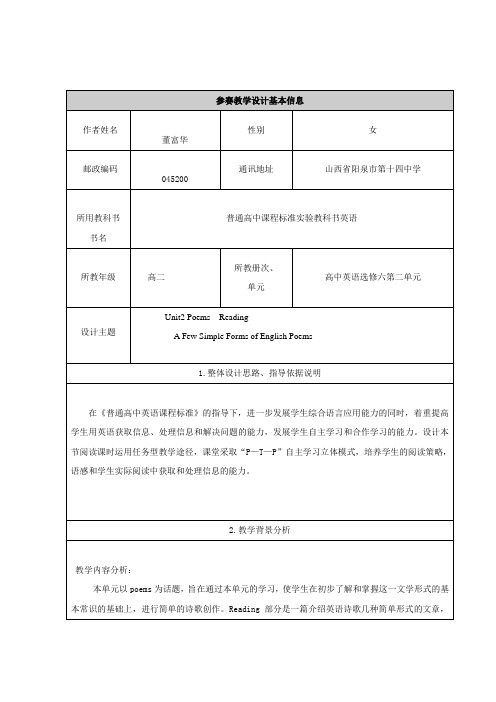
高二学生已经对中国诗歌比较熟悉,那么从我国诗歌入手不仅可以让学生复习诗歌的相关知识为下一步英语诗歌的学习奠定基础,而且激发学生的学习兴趣和课堂主动参与性。
高二学生在经过高一学期学习策略的训练和培养后,基本掌握了略读、查读、归纳大意等阅读技巧,具有一定的阅读能力。但仍有一部分学生基础薄弱,学习积极性较差,那么在教学活动设计中注意层次性、激励性,注重以小组的形式鼓励学生参与到课堂活动中,培养关爱同学和集体主义精神。
参赛教学设计基本信息
作者姓名
董富华
性别
女
邮政编码
045200
通讯地址
山西省阳泉市第十四中学
所用教科书
书名
普通高中课程标准实验教科书英语
所教年级
高二
所教册次、
单元
高中英语选修六第二单元
设计主题
Unit2 Poems Reading
A Few Simple Forms of English Poems
1.整体设计思路、指导依据说明
3) Present some English poems and encourage the students to think aboutthe characteristicsof poems.
4)How to speak 诗歌、诗人、诗歌(总称)、韵, 压韵、节奏 in English.
从熟悉的中文诗歌入手容易激发学生学习兴趣,激活他们的思维;从英文转译到中文诗歌为下文的学习埋下伏笔,接着呈现英文诗歌引导学生中英对比,自主归纳诗歌的特点,顺势学习诗歌知识的英文表达方式,扩大词汇量,减轻阅读中的困难,增强信心。
5.教学过程设计
(中文为主 + 所教学科目标语言)
Step 1Warming up
高中英语优秀教案 选修六 Unit2 Poems Period (人教版)

Unit 2Poems单元要览本单元的中心话题是诗歌。
阅读文章中涉及诗歌的韵律和节奏,并介绍了几种不同内容和形式的简单诗歌。
本单元语言知识的选择和听说读写等语言技能的训练主要围绕“诗歌”这一主题进行。
本单元的目的在于帮助学生掌握与“诗歌”这一主题有关的词汇知识,让学生了解诗歌的一些基本特征和写作方法,从而学会欣赏这些优美的文学作品,最终能够自己尝试写简单的诗歌。
Period 1Warming Up,Pre-reading,Reading and Comprehending整体设计教学内容分析This is the first teaching period of this unit.The central part of this period is the reading passage with the name of A Few Simple Forms of English Poems showing the students a few kinds of simple English poems.Warming Up gives three questions for students to discuss so that they can recall any poems they have ever learned and think about different reasons why people write poems.Pre-reading provides one question for students to think about and a table for students to fill in so as to help students focus on the topic of the reading passage and lead the students to skim the poems on the following pages and know about the general idea of the text.Reading mainly explains the reasons why people write poetry and introduces five simple forms of English poems.Nursery rhymes are the first poems that children will hear.These poems may not make any sense but they areeasy to learn and recite.It is a good way for children to learn about language.List poems often list things,usually having many lines.They have repetition in them and sometimes they have words that rhyme.Cinquains are all made up of five lines and have the fixed structure.Haiku is a Japanese form of poetry that is made up of 17 syllables.It is almost like a photo or painting as it creates a strong image using very few words.Tang poems are famous poems from Ancient China.They have strong imagery and are often about the bringing together of opposites.Comprehending consists of three groups of exercises for the students to do so as to help the students to get a better understanding of the text,that is to say,to help the teacher to check how much the students have understood the text.三维目标设计Knowledge and skills1.To know the meanings of the following new words and phrases:tick(给……标记号),rhyme(韵;押韵),convey(传达;运送),nursery(托儿所),concrete(具体的),contradictory(引起矛盾的;好反驳的),diamond(钻石;菱形),flexible(灵活的;可弯曲的),pattern(模式;式样;图案),cottage(村舍;小屋),sparrow(麻雀),take it easy(轻松;不紧张;从容),run out of(用完),be made up of(由……构成),tease(取笑;招惹;戏弄),salty(含盐的;咸的),endless(无穷的;无止境的),minimum(最低限度;最少量),translation(翻译;译文),branch(枝条;支流;部门),in particular(尤其;特别) 2.To learn about some simple forms of English poems.3.To develop the students' reading ability by skimming and scanning the passage.4.To develop the students' speaking ability by talking about some features of some simple forms of English poems.Process and methods1.While doing Warming Up the teacher can ask the students to think back and try to remember poems from both their early childhood and more recent years.Ask students to complete Exercise 1 in groups.Ask them what they notice about these poems,then get students to recite any poems or parts of poems they can remember so as to arouse their interest in studying the whole unit.2.During Pre-reading the teacher can go around the classroom and discuss the questions with several students.This discussion should be student-centered and arouse students' interest in English poetry.The teacher should also ask the students to skim the text so as to let them have a general knowledge of some simple forms of English poems.3.While doing Reading and Comprehending,the teacher may first have the students close their books and listen to the text with their eyes closed.This gives the students the opportunity to listen to the sounds or “music” of the poems before reading them in more detail.Then ask the students to read the text quickly to get the general idea of the passage.After detailed reading of the passage,students are encouraged to answer some questions and discuss the features of each kind of the poems.4.To consolidate the contents of the reading passage,the students should be required to retell the five kinds of poems in their own words at the end of the class.Emotion,attitude and value1.To cultivate students' appreciation of poetry and the ability of understanding,enjoying and writing poems.2.To develop students' sense of cooperative learning.教学重、难点1.To enable the students to learn about some simple forms of English poetry and to develop their reading ability.2.To enable the students to write their own poems.教学过程Step 1Warming up1.V ocabulary in ReadingMatch the words and phrases with their proper meanings.1.convey()A.sameness of sound between words or syllables,esp.in the end of lines2.cottage ()B.a strong feeling such as love,fear or anger3.tease ()C.make fun of somebody in an unkind way4.rhyme ()D.a place where young children are cared for5.translate ()E.make(ideas,feelings,etc.)known to another person6.endless ()e up7.nursery ()G.small simple house,esp.in the country8.emotion ()H.relax9.take it easy ()I.express sth.in a different language10.run out of ()J.without endSuggested answers:1.E 2.G 3.C 4.A 5.I 6.J7.D8.B9.H10.F2.Warming up by asking students to complete Exercise 1 in groups.Get the students to recite the little poems and songs they can remember.Ask them what they notice about these poems.For example,perhaps they have a strong beat,or they rhyme,or they play with words and sounds,or perhaps some of them are funny because they make no sense.3.Warming up by doing Exercise 2 with students.Then get them into groups as this might prompt their memories.Get the students to recite any poems or parts of poems they can remember.(If the students can't recite any poems or parts of poems,prepare a couple of poems that they would know,in Chinese or English.) 4.Tell students that there are many reasons why people write poetry.Give the examples in Exercise 3.Ask students the reasons they think the poets wrote the poems they have just recited.Write their suggestions on the blackboard.Step 2Pre-reading1.Match the following information.Du Fu Tang DynastyFan Zhongyan Song DynastyMeng Haoran ModernGuo Moruo ModernXu Zhimo Tang DynastyByron AmericaShelly EnglandWhitman EnglandTagore IndiaSuggested answers:Du Fu:Tang Dynasty;Fan Zhongyan:Song Dynasty;Meng Haoran:Tang Dynasty;Guo Moruo:Modern;Xu Zhimo:Modern;Byron:England;Shelly:England;Whitman:America;Tagore:India2.Ask students to do Exercise 1 in groups.Get them to tell the class their favourite poems and the reasons.This might be something they find hard to articulate as the poem might just give them a special feeling that's hard to talk about.Or they might say things like:It makes me feel sad.I like the sounds in it.I like its language,it's funny,and my mother used to recite it to me...3.The purpose of Exercise 2 is to practice an important reading skill:scanning a text,that is,looking through a text quickly to find specific information.1.Fast-reading:Read the reading passage quickly,try to get its general idea and answer the following questions.(1)What is the main idea of the reading passage?________________________________________________________________________(2)How many kinds of poems does the reading passage talk about? And which of the following is not mentioned?A.Nursery rhymes.B.Tang poems.C.Haiku.D.Adverb poems.E.List poems.F.Cinquain.Suggested answers:(1)A brief introduction of a few simple forms of English poems.(2)Five.D is not mentioned.2.Detailed-reading:Read the text thoroughly and do the following exercises.(You may do some searching reading when necessary.)(1)Give out the names of the forms of poems according to the descriptions.①______ are the first poems that children will hear.They are often sung.Children love to move and dance to them because they have strong regular rhythms.They enjoy the rhymes and the way they play with sounds.②______ is made up of five lines and has the following structure:Line 1:a noun that names the subject of the poemLine 2:two adjectives that describe the subjectLine 3:three verbs ending with-ing that describe the subject's actionsLine 4:four words that give the writer's opinions or feelings about the subjectLine 5:a word that gives another name for the subject③______ is a centuries-old form of Japanese poetry.It is made up of 17 syllables and has the following structure:Line 1:5 syllablesLine 2:7 syllablesLine 3:5 syllables④______ are a list of things.They can have as many lines as the writer likes.Sometimes they have repetition in them and sometimes they have words that rhyme.When a list poem has rhyming words,it also has a regular rhythm.⑤When translated into English,______ have a free form(that is,without a regular rhythm)and do not rhyme.They have strong imagery and are often about the bringing together of opposites.(2)Find the strong rhythm and rhyme in Poem A.e.g.In the first two lines,there are word_&_mockingbird. So in the following lines,there are ______;______;______;______.(3)What's the difference between Poems B and C though they are both list poems?________________________________________________________________________(4)Which of the poems in the reading passage can give you a clear picture in your mind?________________________________________________________________________(5)Can you find out the 17 syllables in Poem F?e.g.“A” has 1 syllable,“fallen” has 2 syllables,while “blossom” has 2 syllables.________________________________________________________________________.(6)Can you give a proper title to Poem H either in English or Chinese?________________________________________________________________________Suggested answers:(1)①Nursery rhymes②The cinquain③Haiku④List poems⑤Tang poems(2)sing & ring;brass & looking-glass;broke & billy-goat;away & today(3)Poem B repeats phrases and rhymes,while Poem C does not.(4)Most probably Poems D,F,G and H.(5)A(1);fallen(2);blossom(2);Is(1);coming(2);back(1);to(1);the(1);branch(1);Look(1);a(1);butterfly(3)(6)望夫石/A Loyal WifeStep 4Language studyDeal with language problems if any(words or sentences students might not understand)to help the students to have a better understanding of the text.Step 5Listening,reading aloud and underliningAsk students to read the passage aloud to the tape and let them pay attention to the pronunciation of each word and the pauses within each sentence.Tell them to pick out all the useful expressions or collocations from the passage while reading and copy them to the notebook after class as homework.Collocations:make sense,give...a strong impression,on fire,take it easy,run out of,make up of,be translated into,day by day,in particular.Step 6Structure analyzingAfter reading,ask students to discuss the text structure.Keys for reference:This passage is an introduction of some of the simple forms of English poems.The first paragraph introduces the topic and the theme of the text,explaining the purpose of poetry writing,that is,to give readers a strong impression or to convey certain emotions.From the second paragraph,the text analyses the different kinds of poems and gives examples for reference.The last paragraph encourages students to have a try and write poems of their own.Step 7RetellingAsk students to talk about the different kinds of poems in their own words.Give them some key words and expressions on the blackboard.Then let them try to retell the passage.Step 8Homework1.Learn the useful new words and expressions in this period by heart.2.Try to find some selections of poems and appreciate their beauty and eventually try to write some poems of your own.Step 9Reflection after teaching________________________________________________________________________________________________________________________________________________Reading:A Few Simple Forms of English Poems李东玲,海南省儋州市民族中学,本教案获2008年度“教科杯”海南省中小学教师教学论文和教学设计大赛二等奖教学参考Ⅰ.Famous poetry in EnglishReading poetry brings people from different places and different times together.More than any other form of literature,poetry plays with sounds,words and grammar.That makes poetry difficult to write,but very interesting to read.Poetry also calls up all the colors,feelings,experiences and curious images of a dream world.Though it has a short history,there is a lot of good English poetry around.The seventeenth century was a great time for English poetry.Shakespeare is most famous for his plays.His sonnets,however,belong to the best English poetry.In the next generation of the English poets we meet John Donne.Chinese readers admire his works because of his use of surprising images that reminds them of the works of poets such as Su Dongpo.Before the end of the century,there was another famous writer,John Milton.Once published,his works became famous for the absence rhyme at the end of each line.In the eighteenth century it was Alexander Pope who wrote the finest poetry in England.The next period that produced a great number of fine poets was the nineteenth century.Greatly loved in China are the English Romantic poets.John Keats died at a very young age in 1821,while William Wordsworth,who spent much of his time in his English Lake District,lived to the age of the 80 and died in 1850.The nature poems by William Wordsworth,George Gordon Byron's Isles of Greece and the sonnets and long poems by John Keats have long been favorites.The style in their poems has often led to comparisons with poets such as Du Fu and Li Bai.Finally,modern poets have their special attraction because they stand closest to us both in the language and images they use.Among them we find the American poet Robert Frost.More and more people are interested to read modern poetry in English.Translation can be good,but being able to read English gives you much choice.Besides,no matter how well a poet is translated,something of the spirit of the original work is lost.Reading poetry in English also opens the door to finding new ways of expressing yourself in Chinese.Ⅱ.What is free verse?Free verse is a modern form of poetry which does not follow any specific rhyme or metrical scheme,although it does not completely abandon the basic poetic precepts of heightened language and songs.Free verse poetry is said to have been popularized by such notable poets as Walt Whitman and Emily Dickinson during the late 19th century,although earlier poets like the mystic William Blake were beginning to pull away from the restrictions of the formal poetry of their day.Whitman's signature collection,Leaves of Grass,is almost entirely composed of free verse poetry.Dickinson,however,still wrote much of her poetry according to the metrics and rhyme of a favored hymn composer.The free verse style of poetry soon became popular with rebellious young poets such as the Frenchman Artur Rimbaud(阿图尔·兰波),who wrote many of his best free verse poems before the age of 18.Other poets embraced free verse poetry as a way to express raw emotions or unbridled passion not generally found in the formal poetry of their time.Whitman himself referred to this artistic awakening as the great Y AWP,a call for all artists to break free of social conventions and live life to its fullest.Free verse poetry continued to evolve throughout the 20th century,beginning with poets such as Carl Sandburg(卡尔·桑博格)and Robert Frost(罗伯特·弗罗斯特),both of whom were equally comfortable with formal and free verse poetry.Perhaps the most admired free verse poet was the expatriate Ezra Pound,who became a mentor to many of the 20th century's most famous authors and poets.Period 2Language Study整体设计教学内容分析The emphasis of this period will be placed on the important new words,phrases and sentence patterns in Warming Up,Pre-reading,Reading,Comprehending and Discovering useful words and expressions in Learning about Language.There are altogether 50 new words and phrases in these five parts.22 of them are marked with triangles,which shows that the students needn't learn them by heart.It is enough to recognize them when meeting them while reading the passage.The other 28 should all be remembered,among which the following 8 words and expressions are even more important:concrete,take it easy,in particular,flexible,eventually,transform,run out of,be made up of.They are all very useful and important.So are the sentence patterns “Some poems tell a story or describe something in a way that will give the reader a strong impression.”,“Some rhyme(like B) while others do not(like C).” and “Another simple form of poem that students can easily write is the cinquain,a poem made up of five lines.” We ought to pay more attention to them.三维目标设计Knowledge and skills1.To get the students to learn to use the following important new words and phrases freely:rhyme,concrete,pattern,tease,endless,translation,take it easy,in particular,convey,flexible,branch,eventually,transform,forever,run out of,be made up of.2.To get the students to understand and use the following important and useful sentence patterns:(1)Some poems tell a story or describe something in_a_way_that_will_give_the_reader_a_strong_impression.(2)Some rhyme(like B) while others do not(like C).(3)Another simple form of poem that students can easily write is the cinquain,a poem made_up_of_five_lines.Process and methods1.To help the students to understand the meanings of the above useful new words and expressions in the context,and then give some explanations about them,and at last offer some exercises to make the students master their usages.2.To ask the students to make up their own sentences by imitating the above sentence patterns.3.At the end of the class,make students do more exercises for consolidation.In doing so,they can learn,grasp and use these important language points well.Emotion,attitude and value1.To stimulate students' interest in learning English.2.To develop students' sense of cooperation and teamwork.教学重、难点1.Important new words and expressions:rhyme,concrete,pattern,tease,endless,translation,take it easy,in particular,convey,flexible,branch,eventually,transform,forever,run out of,be made up of.2.Important and useful sentence patterns:(1)The attributive clause with the antecedent “way”.(2)Compound sentences with “while”.(3)Past participles as the postpositive attributive.3.Some difficult and long sentences in the text.教学过程Step 1Revision1.Check the homework exercises.2.Ask some students to tell about some simple forms of English poems.Step 2Reading and findingGet students to read through Warming Up,Pre-reading,Reading,Comprehending and Discovering useful words and expressions in Learning about Language to underline all the new words and useful expressions or collocations in these parts.Read them aloud and copy them down in the exercise book.Step 3Practice for useful words and expressions1.Turn to Page 12.Go through the exercises in Discovering useful words and expressions with students and make sure they know what to do.2.Give them several minutes to finish the exercises.They may first do them individually,and then discuss them with their partners.3.Check the answers with the whole class and explain the problems they meet where necessary.Step 4Vocabulary studyⅠ.简单知识扫描1.poem/poetry(P9)Poet(P10)【原句再现】These little poems and songs might have been some of the first poetry you learned.这些小诗歌或许就是你最早学到的一些诗歌。
Unit2 Poem(选修6) 市级公开课教案
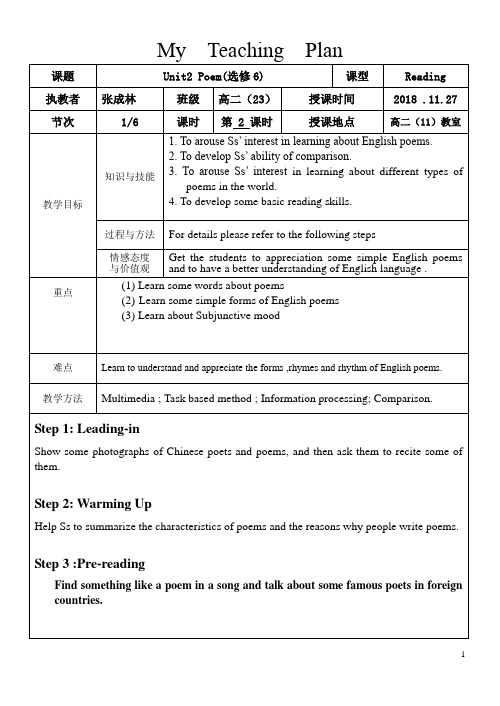
My Teaching Plan课题Unit2 Poem(选修6) 课型Reading 执教者张成林班级高二(23)授课时间2018 .11.27 节次1/6 课时第 2 课时授课地点高二(11)教室教学目标知识与技能1. To arouse Ss’ interest in learning about English poems.2. To develop Ss’ ability of comparison.3. To arouse Ss’ interest in learning about different types ofpoems in the world.4. To develop some basic reading skills.过程与方法For details please refer to the following steps情感态度与价值观Get the students to appreciation some simple English poemsand to have a better understanding of English language .重点(1) Learn some words about poems(2)Learn some simple forms of English poems(3) Learn about Subjunctive mood难点Learn to understand and appreciate the forms ,rhymes and rhythm of English poems.教学方法Multimedia ; Task based method ; Information processing; Comparison. Step 1: Leading-inShow some photographs of Chinese poets and poems, and then ask them to recite some of them.Step 2: Warming UpHelp Ss to summarize the characteristics of poems and the reasons why people write poems.Step 3 :Pre-readingFind something like a poem in a song and talk about some famous poets in foreign countries.Step 4 :While-reading:1.Task1: fast readingThe reading passage discusses five kinds of poems. What are they?2.Task2. fast reading(1).what’s the main topic of the passage ?(2). What’s the main idea of Para. 1?3.Task:3 Do careful reading to find out the characteristics of each kind of poem andlearn to understand and appreciate them .4.Task4:Find the words that rhyme in Poem A and Poem B.5. Task 5: DiscussionWhat is the story that poem H tells?Step 5:Post-reading:1. Task6:Guess the forms of the given poems2.Task7: Fill in the following form.3. Task8: Fill in the blanks to impress ourselves on what we have learned.Step 6:Homework:1.Read the text fluently and underline the language problems.2. Get on the line and find out more beautiful English poems.Let’s enjoy an English poem in the form of a song to end our class.。
英语:unit 2《Poems》教案-reading1(新人教版选修6)
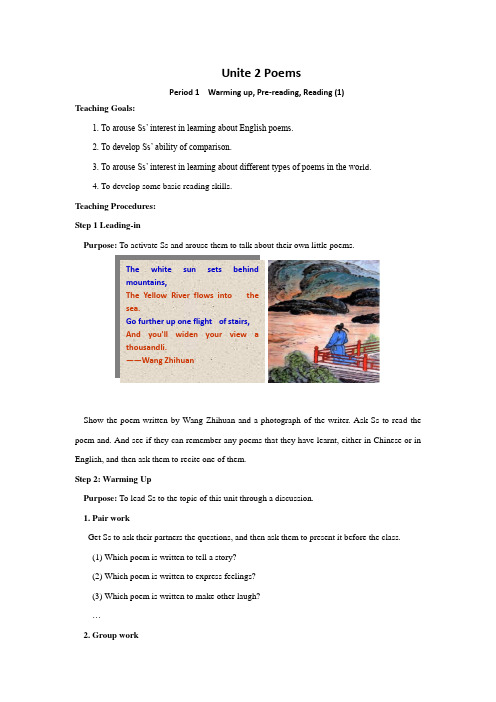
Unite 2 PoemsPeriod 1 Warming up, Pre-reading, Reading (1)Teaching Goals:1. To arouse Ss’ interest in learning about English poems.2. To develop Ss’ ability of comparison.3. To arouse Ss’ interest in learning about different types of poems in the wo rld.4. To develop some basic reading skills.Teaching Procedures:Step 1 Leading-inPurpose: To activate Ss and arouse them to talk about their own little poems.The white sun sets behindmountains,The Yellow River flows into thesea.Go further up one flight of stairs,And you'll widen your view athousandli.——Wang ZhihuanShow the poem written by Wang Zhihuan and a photograph of the writer. Ask Ss to read the poem and. And see if they can remember any poems that they have learnt, either in Chinese or in English, and then ask them to recite one of them.Step 2: Warming UpPurpose: To lead Ss to the topic of this unit through a discussion.1. Pair workGet Ss to ask their partners the questions, and then ask them to present it before the class.(1) Which poem is written to tell a story?(2) Which poem is written to express feelings?(3) Which poem is written to make other laugh?…2. Group workGet Ss to talk about the world famous poets. The pictures below can be used for Ss to talk about, and Ss can also talk as much as they can.William Shakespeare George Gordon Byron Li Bai威廉·莎士比亚乔治·戈登·拜伦李白(1) William Shakespeare: English playwright and poet whose body of works is consideredthe greatest in English literature. His plays, many of which wereperformed at the Globe Theatre in London, include historical works,such as Richard II, comedies, including Much Ado about Nothing andAs You Like It, and tragedies, such as Hamlet, Othello, and KingLear. He also composed 154 sonnets. The earliest collected edition ofhis plays, the First Folio, contained 36 plays and was publishedposthumously (1623).(2) George Gordon Byron: British poet acclaimed as one of the leading figures of theRomantic Movement. The Byronic hero lonely, rebellious, andbrooding first appeared in Manfred (1817). Among his other works areChilde Harold (1812-1818), The Prisoner of Chilton (1816), and theepic satire Don Juan (1819-1824). Byron was notorious for his loveaffairs and unconventional lifestyle. He died while working to secureGreek independence from the Turks.(3) Li Bai: Chinese poet who spent much of his time wandering and composingromantic, wine-inspired verse.Conclusion: All these poets are well known to the whole world and do you know any poems written by them? Can you recite to all the class?Step 3. Pre-readingPurpose: To help Ss learn about the context of the Reading part.1. Group workAsk Ss to discuss the questions with their partners in groups of four.(1) Do you have a favorite poem in Chinese?(2) Why is it your favorite poem?(3) Do you have a favorite poem in English?(4) Why is it your favorite poem?For example:(1) My favorite poem in Chinese is: 去年今日此门中,人面桃花相映红。
人教版高中英语选修6《Unit 2 Poems》教案2篇
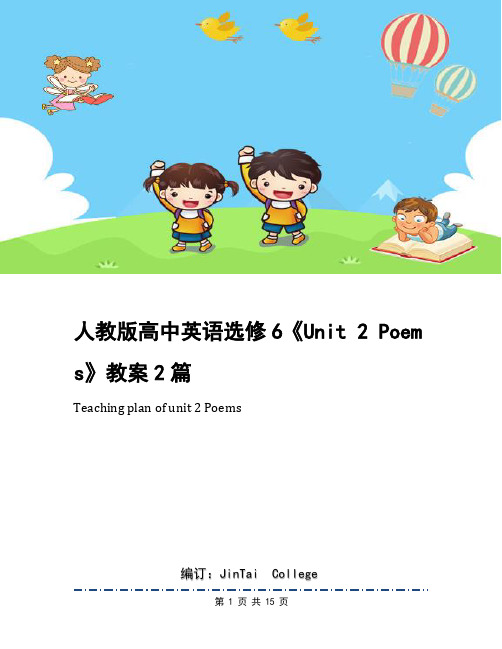
人教版高中英语选修6《Unit 2 Poem s》教案2篇Teaching plan of unit 2 Poems编订:JinTai College人教版高中英语选修6《Unit 2 Poems》教案2篇前言:英语作为在许多国际组织或者会议上都是必需语言,几乎所有学校选择英语作为其主要或唯一的外语必修课。
英语教学涉及多种专业理论知识,包括语言学、第二语言习得、词汇学、句法学、文体学、语料库理论、认知心理学等内容。
本教案根据英语课程标准的要求和教学对象的特点,将教学诸要素有序安排,确定合适的教学方案的设想和计划、并以启迪发展学生智力为根本目的。
便于学习和使用,本文档下载后内容可按需编辑修改及打印。
本文简要目录如下:【下载该文档后使用Word打开,按住键盘Ctrl键且鼠标单击目录内容即可跳转到对应篇章】1、篇章1:人教版高中英语选修6《Unit 2 Poems》教案2、篇章2:人教版高中英语选修6《Unit 2 Poems》教案篇章1:人教版高中英语选修6《Unit 2 Poems》教案教学准备教学目标教学目标(Teaching Aims)知识与技能(Knowledge and Skills)1.了解教学大纲关于语法填空的命题特点。
2.能够根据语法填空的命题特点自己编语法填空的题目3.掌握语法填空的解题方法与技巧过程与方法(Process and Methods)让每一位同学都能参与到课堂教学与活动中来,以小组或结对的形式进行相互学习和讨论。
情感态度与价值观(Feeling, Attitudes and Values)学习应对语法填空是与课文相结合,让学生在了解各种不同诗歌形式的背景下学习语法填空的设题与解题特点,从而更加理解英语诗歌的特色,更加懂得如何阅读和欣赏英语诗歌。
教学重难点教学重点(Important Points):1.让学生了解语法填空的命题特点2.掌握语法填空的解题方法与技巧教学难点(Difficult Points):语法填空中词性的转换教学过程(Teachers’ Activities)Step I: Lead-in① Review the new words and expressions of this unit by them together, and then do Task 1---speak out the other forms according to the giv en words② Listen to the song Jingle Bells and try tofill a word into each blank.Step II : Pre-practising1.Questions① Do you think it is difficult to complete the items of blank-filling with grammar knowledge?② Have you figur ed out the characteristics of the item?2.ExplainingIn this item there are 10 blanks for you to fill in with less than one proper word① some blanks with a given word while otherswith none② fill in the blanks with the proper form of the given word according to its grammatical and logical meaning.③ choose a preposition, pronoun, conjunction or an article to fill in the blank without any given word.3.DiscussionHow can we finish the items step by step with our grammar knowledge?① ___________________________________________.② _ __________________________________________.③ ___________________________________________.Step III : While-practising1.Making an item of grammatical blank-filling based on the para graph of the text.① more than 5 blanks.② some blanks with given word.③ others with none.2.exchange the item you made for your partner to complete it .3.The whole class finis h the one the teacher prepared for them.Step IV : Post-practising1.Check some of the students’ anwsers and give comments.2.Draw a conclusionStep V: Homework Assign ment1.Further improve your skills of dealing with the grammar filling.plete Ex.2 on Page 10, Nanfang New Class篇章2:人教版高中英语选修6《Unit 2 Poems》教案【按住Ctrl键点此返回目录】教学准备教学目标Teaching goals1.Target languagea. Important words and phrasesPoem, poetry, recite, aspect, convey, nursery, rhyme, diamond, cottage, balloon, sparrow, tease, salty, endless, translate, nursery rhyme, take it easy, run out of, make up ofb. Important sentencesWhich poem is about things that don’t make sense?Poets use many different forms of poems toexpress themselves.I hadn’t taken my eye off the ball.We hadn’t taken it easy.The poem is made up of five lines.A lot of Tang poetry has been translated into English. The translations have a free form that English people like to copy.2.Ability goalsa. Enable Ss to talk about different types of poems: nursery rhymes; list poems; cinquain,; haiku; Tang poemsb. Enable Ss to talk about different purposes of writing poems.c. Understand the main theme of each poem.d. Enable Ss to chant some of their favorite poems.3.Learning abilityEnable Ss to distinguish different types of poems 教学重难点Teaching important points1.Talk about five main types of poems.2.Understand the main purpose of writing the poems.Teaching difficult points1.Find the rhythm of each poem.2.Chant the poem.3.Understand the main purpose of writing the poems.教学过程Teaching procedures to share a feeling or experience; to describe something in detail or give an impression; to get the reader to think about an idea; to express a point of view; to make the reader experience the sight, sounds, smells, feel and tastes of something; to create a mood, to play with words--- their sounds, rhyme and rhythm.)If time permits, in small groups or as a class, discuss the kinds of topics that poets write about.( people, animals, nature, landscapes, the sea, the seasons, stories, death, war, youth and old age,feeling and experiences, emotions like love, hate, sadness, regret and desire, etc.)Step 4.Pre-readingPeople from different countries write different kinds of poems. Get Ss to discuss the questions on Page 9 with their partners: Do you have a favorite poem in Chinese? Why ? Do you have a favorite poem in English? Why?As to exercise 2, give Ss practice in animportant reading skill: scanning a text, that is, looking through a text quickly to find specific information. Read the table in exercise 2 with the Ss. Tell them that they are going to look for the information in the table, just in the poems themselves, not in the other parts of the text. They are to look only for those pieces of information and not readevery word. Do an example with them.Suggested answers to exercise 2:Step 5.ReadingScanningGet the Ss to read the passage quickly and accurately and meanwhile help the Ss to form a good habit of reading. Teacher gives Ss a couple of minutes to look through the whole passage. Tell them to read the text silently and then ask some detailed questions about the text on the slide show . Teacher should encourage Ss to express their ideas.Q1.Why do people write poetry?Q2.How many forms of poems are mentioned in the passage? What are they?Q3.What does “nursery rhyme” mean? Why do they delight small children?Q4.What’s the characteristic of “list poems”? What about “cinquain”?Q5.Why do English People like “Haiku”?Q6.Are you familiar with Tang Poems? Do you know the title of the last poem in the text?ListeningBefore Ss read the text, have them close their books and listen to the text with their eyes closed. This gives Ss the opportunity to listen to the sounds or “music” of the poems before reading them in detail. Tell them that it doesn’t ma tter if they don’t understand every word.First readingGet Ss to read the text carefully, finding the one sentence that sums up the paragraph of each part.. Underline the topic sentence.Second readingTell Ss that they are going to look at the rhythm of two of the poems. Make sure they know what rhythm is. Read the limerick aloud and have Ss listen for the strong beats. Then have them clap the strong beats asyou read. Mark the strong beats on the limerick on the board.There was an old man with a beardWho said “it is just as I feared”.“Four insects and thenTwo birds and a henHave all made a home in my beard”.Now read the poem A & B. Ask them to mark the strong beats on the two poems that have a strong rhythm. Check their answers . Then play the tape and get them to clap to the strong beats in those two poems.Third readingJust as any scene can serve as the subject of a painting, so any part of daily life can provide material for a poem.. Of course, the choice that the artist or poet makes relates to his or her purpose. Poetry is usually short and compact, so it should beread several times, preferably aloud, to appreciateits meaning. Read the last poem (Poem H), and answer the following questions:Q1.What parts of the poem suggest that the woman loves her husband?Q2.How do you understand the sentence” Shouldthe journeyer return, this stone would utter speech.”? Explain the sentence in your own words.Q3.What picture do you have in your mind when you read the above sentences?Q4.Do you know the Chinese title of this poem? Do you know the Chinese version of the poem?Step 6.Make a short summary of this period.课后习题Homework1.Surf some websites to find out more information about poets.2.Review the content of the reading passage.3.Finish the exercises on Page 12& 13.-------- Designed By JinTai College ---------。
高中英语选修6《Unit 2 Poems》教案人教版
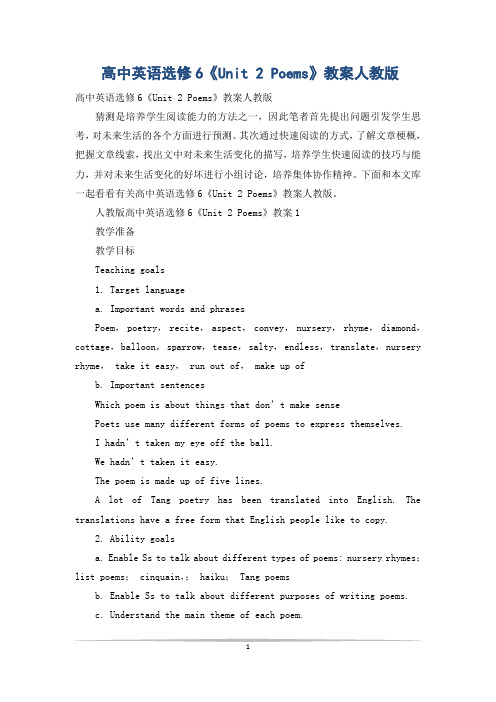
高中英语选修6《Unit 2 Poems》教案人教版高中英语选修6《Unit 2 Poems》教案人教版猜测是培养学生阅读能力的方法之一,因此笔者首先提出问题引发学生思考,对未来生活的各个方面进行预测。
其次通过快速阅读的方式,了解文章梗概,把握文章线索,找出文中对未来生活变化的描写,培养学生快速阅读的技巧与能力,并对未来生活变化的好坏进行小组讨论,培养集体协作精神。
下面和本文库一起看看有关高中英语选修6《Unit 2 Poems》教案人教版。
人教版高中英语选修6《Unit 2 Poems》教案1教学准备教学目标Teaching goals1. Target languagea. Important words and phrasesPoem, poetry, recite, aspect, convey, nursery, rhyme, diamond,cottage, balloon, sparrow, tease, salty, endless, translate, nursery rhyme, take it easy, run out of, make up ofb. Important sentencesWhich poem is about things that don’t make sensePoets use many different forms of poems to express themselves.I hadn’t taken my eye off the ball.We hadn’t taken it easy.The poem is made up of five lines.A lot of Tang poetry has been translated into English. The translations have a free form that English people like to copy.2. Ability goalsa. Enable Ss to talk about different types of poems: nursery rhymes;list poems; cinquain,; haiku; Tang poemsb. Enable Ss to talk about different purposes of writing poems.c. Understand the main theme of each poem.d. Enable Ss to chant some of their favorite poems.3. Learning abilityEnable Ss to distinguish different types of poems教学重难点Teaching important points1. Talk about five main types of poems.2. Understand the main purpose of writing the poems.Teaching difficult points1. Find the rhythm of each poem.2. Chant the poem.3. Understand the main purpose of writing the poems.教学过程Teaching procedures … waysStep 1. GreetingsStep 2. PresentationAsk Ss to think back and try to remember poems from their early childhood, either in Chinese or in English.Talk about some famous poets both home and abroad, either ancient ones or modern ones.Brainstorming: What will you think of when we talk about the word "poem"Step 3. Warming upRead the questions in this part, reminding Ss what they notice about the above poems.(e.g. they have a strong beat, or they have rhyme, or they play with words and sounds, or perhaps some of them are funny because they make no sense.)Tell Ss that there are many reasons why people write poetry. Give the examples on the Bb. Ask Ss why they think the poets wrote the poems they have just recited.. Write their suggestions on the board.Give Ss a time limit of a few minutes. Divide the class into groups of four to discuss the purpose of writing poems. Ask one person from each group to read their group’s list and add their suggestions to the list on the board. (Suggested reasons: to create certain feelings or images in the reader; to share a feeling or experience; to describe something in detail or give an impression; to get the reader to think about an idea;to express a point of view; to make the reader experience the sight,sounds, smells, feel and tastes of something; to create a mood, to play with words--- their sounds, rhyme and rhythm.)If time permits, in small groups or as a class, discuss the kinds of topics that poets write about.( people, animals, nature, landscapes,the sea, the seasons, stories, death, war, youth and old age, feeling and experiences, emotions like love, hate, sadness, regret and desire,etc.)Step 4. Pre-readingPeople from different countries write different kinds of poems. Get Ss to discuss the questions on Page 9 with their partners: Do you have a favorite poem in Chinese Why Do you have a favorite poem in English WhyAs to exercise 2, give Ss practice in an important reading skill: scanning a text, that is, looking through a text quickly to find specific information. Read the table in exercise 2 with the Ss. Tell them that they are going to look for the information in the table, just in the poems themselves, not in the other parts of the text. They are to look only for those pieces of information and not read every word. Do an example with them.Suggested answers to exercise 2:Step 5. ReadingScanningGet the Ss to read the passage quickly and accurately and meanwhile help the Ss to form a good habit of reading. Teacher gives Ss a couple of minutes to look through the whole passage. Tell them to read the text silently and then ask some detailed questions about the text on the slide show . Teacher should encourage Ss to express their ideas.Q1. Why do people write poetryQ2. How many forms of poems are mentioned in the passage What are they Q3. What does "nursery rhyme"mean Why do they delight small childrenQ4. What’s the characteristic of "list poems"What about "cinquain"Q5. Why do English People like "Haiku"Q6. Are you familiar with Tang Poems Do you know the title of the last poem in the textListeningBefore Ss read the text, have them close their books and listen to the text with their eyes closed. This gives Ss the opportunity to listen to the sounds or "music" of the poems before reading them in detail. Tell them that it doesn’t matter if they don’t understand every word. First readingGet Ss to read the text carefully, finding the one sentence that sums up the paragraph of each part.. Underline the topic sentence.Second readingTell Ss that they are going to look at the rhythm of two of the poems. Make sure they know what rhythm is. Read the limerick aloud and have Ss listen for the strong beats. Then have them clap the strong beats as you read. Mark the strong beats on the limerick on the board.There was an old man with a beardWho said "it is just as I feared"."Four insects and thenTwo birds and a henHave all made a home in my beard".Now read the poem A … B. Ask them to mark the strong beats on the two poems that have a strong rhythm. Check their answers . Then play the tape and get them to clap to the strong beats in those two poems.Third readingJust as any scene can serve as the subject of a painting, so any part of daily life can provide material for a poem.. Of course, the choice that the artist or poet makes relates to his or her purpose. Poetry is usually short and compact, so it should be read several times, preferably aloud, to appreciate its meaning. Read the last poem (Poem H), and answer the following questions:Q1. What parts of the poem suggest that the woman loves her husband Q2. How do you understand the sentence" Should the journeyer return,this stone would utter speech." Explain the sentence in your own words. Q3. What picture do you have in your mind when you read the above sentencesQ4. Do you know the Chinese title of this poem Do you know the Chinese version of the poemStep 6. Make a short summary of this period.课后习题Homework1. Surf some websites to find out more information about poets.2. Review the content of the reading passage.3. Finish the exercises on Page 12… 13.人教版高中英语选修6《Unit 2 Poems》教案2教学准备教学目标教学目标(Teaching Aims)知识与技能(Knowledge and Skills)1. 了解教学大纲关于语法填空的命题特点。
人教版高中英语选修6教案Unit 2 Poems
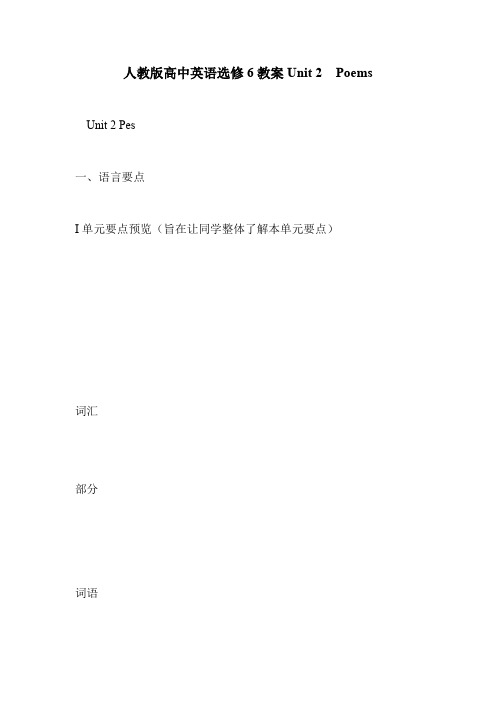
人教版高中英语选修6教案Unit 2 Poems Unit 2 Pes一、语言要点I单元要点预览(旨在让同学整体了解本单元要点)词汇部分词语辨析1pe/petr 2transfr/hange 3apprpriate/suitable/fit 4 run ut/run ut f词形变化1 srr n 悲哀, 悲痛srrful ad 悲伤的2 anger n 怒, 愤怒angr ad 生气的, 愤怒的angril adv 愤怒地3 translate v 翻译, 转变为translatin n 翻译, 译translatr n 翻译者4 ending n 结尾, 结局end v 结束, 终结,end n末端, 尽头重点单词1 aspet n方面;样子;外表2 nve v传达;运送3 nrete ad具体的4 tease v取笑;招惹;戏弄pattern n模式;式样;图案6 underline v在下面画线;强调7 exhange v交换,交流8 spnsr n赞助人;主办者vt发起,举办,倡议重点词组tae it eas从容, 不紧张, 松懈, 轻松ae up f(多用于被动)构成tr ut 试验, 考验, let ut发出, 泄露重点句子1Se pes tell a str r desribe sething in a a that ill give the reader a strng ipressin thers tr t nve ertain etins2 And said thugh strange the all ere true重点语法虚拟语气(II)(见语法专题)II 词语辨析(旨在提供完形填空所需材料)1) pe/petr n 诗歌【解释】pe[]诗歌,诗体petr[U]诗歌的总称【练习】选择pe或petr并用其适当的形式填空1) eats and Shaespeare are asters f English ______2) Peple rite _________ t ae ther laughes: 1) petr 2) pes2) transfr/hange v改变,变化【解释】transfr指“人、物在性质上或形态上发生彻底或基本的变化”hange指“使改变得与原物不同”或“使发生以新代旧的变化”【练习】选择transfr或hange,并用其适当的形式填空1) Heat an __________ ater int stea2) The appearane f the tn is quite ________es: 1) transfr 2) hanged3) apprpriate/suitable/fit ad合适的,适当的【解释】apprpriate 形容事物在特定的时间合适,或与特定场合协调一致。
人教版高二英语选修6Unit2Poems全单元教案

教案1 Unit2 PoemsReadingTeaching material: NSEFC Book 6 —— Unit 2Teaching AimsTo cultivate students’ interest of poetry and improve their reading skills.Teaching Important & Difficult PointsHow to help the students to grasp and remember the detailed information of the reading material. Teaching aids:a tape recorder, a projector, Slides and PicturesTeaching ProcedureStep 1 Warming up1. Which poems and poets can you think of when seeing the following pictures?静夜思李白床前明月光,疑是地上霜。
举头望明月,低头思故乡。
古风其二李绅锄禾日当午,汗滴和下土。
谁知盘中餐,粒粒皆辛苦。
望夫石王健望夫处,江悠悠。
化为石,不回头。
山头日日风复雨,行人归来石应语。
2. Match the following information.Li Bai Song DynastyDu Fu Tang DynastyFan Zhongyan Tang DynastyMeng Haoran ModernGuo Moruo ModernMao Zedong Tang DynastyByron AmericaShelly EnglandEmerson EnglandTagore GermanyGoethe IndiaStep 2 BrainstormingDiscuss the reasons why people write poems.Fast readingScan the passage and answer the following questions.1. What is the main topic of the reading passage?2. What five kinds of poems does the reading passage talk about?different forms of English poemsnursery rhymes, list poems, cinquain, haiku, Tang poems.3. Scan the poems and fill in the following form.Which poem A B C D E F G H describes a person?tells a story?describes an aspect of aperson?is about sport?is about things that don’tmake sense?is recited to a baby?describes a river scene?has rhyming words at theend of lines?repeats words andphrases?Step 3 Careful readingT: Now let’s read the following five poems and finish tasks.Slide showListen to Poem A and pay attention to its rhyming lines and words.Hush, little baby, don’t say a w ord,Papa’s going to buy you a mockingb ird.If that mockingbird won’t s ing,Papa’s going to buy you a diamond r ing.If that diamond ring turns to br ass,Papa’s going to buy you a looking gl ass.If that looking-glass gets br o ke,Papa’s going to buy you a billy-g oa t.If that billy-goat runs aw ay,Papa is going to buy you another d ay.Read the poem by yourself again and answer the following questions.1. What’s the baby’s father going to buy if the lookin g-glass gets broken?2. What is Papa going to buy for the baby if that billy-goat runs away?3. What are the features of it?Keys:1. a billy -goat2. another billy-goat3. It has strong rhythm and rhyme and has a lot of repetition.Poem COur first football matchWe would have won…If Jack had just scored that goal,If we’d had just a few more minutes,If we had trained harder,If Ben had passed the ball to Joe,If we’d had thousands of fans screaming,If I hadn’t taken my eye off the ball,If we ha dn’t stayed up so late the night before,If we hadn’t taken it easy,If we hadn’t run out of energy,We would have won…If we’ve been better!Questions1. Did his or her team win the game?2. Why his or her team didn’t win the game?3. Does the speaker really believe his or her own excuse? How do you know?Keys:1. No, his or her team didn’t win.2. The players didn’t win because: Jack didn’t score that goal; they didn’t have enough time; they hadn’t trained hard….3. The speaker doesn’t really believe his or her own excuses, because there has too many ifs…Poem D&E1. What subject is the speaker writing about?2. Does the speaker like the subject? Give a reason for your answer.T: We have enjoyed so many English poems. Some are traditional forms of English poetry but some are not, for example haiku. (It comes from Japanese).In fact English speaker also have borrowed from another kind of Asian poetry---Tang poems from China.Poem H at the bottom of this passage is a translation from the Chinese. Poem HWhere she awaits her husband,On and on the river flowsNever looking back,Transformed into stone.Day by day upon the mountain top,wind and rain revolve.Should the journey return,this stone would utter speech.(By Wang Jian)望夫石王健望夫处,江悠悠。
人教版高中英语选修六Unit 2 Poems教学设计(1)
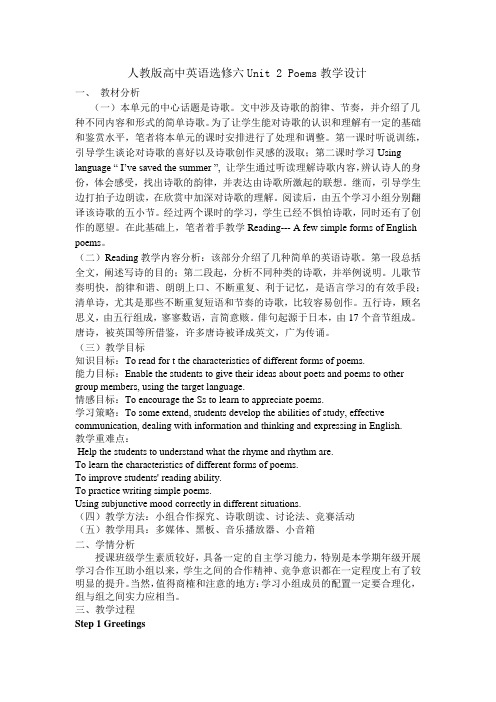
人教版高中英语选修六Unit 2 Poems教学设计一、教材分析(一)本单元的中心话题是诗歌。
文中涉及诗歌的韵律、节奏,并介绍了几种不同内容和形式的简单诗歌。
为了让学生能对诗歌的认识和理解有一定的基础和鉴赏水平,笔者将本单元的课时安排进行了处理和调整。
第一课时听说训练,引导学生谈论对诗歌的喜好以及诗歌创作灵感的汲取;第二课时学习Using language “ I’ve saved the summer ”, 让学生通过听读理解诗歌内容,辨认诗人的身份,体会感受,找出诗歌的韵律,并表达由诗歌所激起的联想。
继而,引导学生边打拍子边朗读,在欣赏中加深对诗歌的理解。
阅读后,由五个学习小组分别翻译该诗歌的五小节。
经过两个课时的学习,学生已经不惧怕诗歌,同时还有了创作的愿望。
在此基础上,笔者着手教学Reading--- A few simple forms of English poems。
(二)Reading教学内容分析:该部分介绍了几种简单的英语诗歌。
第一段总括全文,阐述写诗的目的;第二段起,分析不同种类的诗歌,并举例说明。
儿歌节奏明快,韵律和谐、朗朗上口、不断重复、利于记忆,是语言学习的有效手段;清单诗,尤其是那些不断重复短语和节奏的诗歌,比较容易创作。
五行诗,顾名思义,由五行组成,寥寥数语,言简意赅。
俳句起源于日本,由17个音节组成。
唐诗,被英国等所借鉴,许多唐诗被译成英文,广为传诵。
(三)教学目标知识目标:To read for t the characteristics of different forms of poems.能力目标:Enable the students to give their ideas about poets and poems to other group members, using the target language.情感目标:To encourage the Ss to learn to appreciate poems.学习策略:To some extend, students develop the abilities of study, effective communication, dealing with information and thinking and expressing in English.教学重难点:Help the students to understand what the rhyme and rhythm are.To learn the characteristics of different forms of poems.To improve students' reading ability.To practice writing simple poems.Using subjunctive mood correctly in different situations.(四)教学方法:小组合作探究、诗歌朗读、讨论法、竞赛活动(五)教学用具:多媒体、黑板、音乐播放器、小音箱二、学情分析授课班级学生素质较好,具备一定的自主学习能力,特别是本学期年级开展学习合作互助小组以来,学生之间的合作精神、竞争意识都在一定程度上有了较明显的提升。
人教版高中英语选修六教案:Unit+2+Poems.doc

Teaching topic: New Senior English for ChinaStudent’s Book 6Unit 2 PoemsTeaching type: Using language一、教学背景分析:本单元的中心话题是诗歌,本单元的教学目的是向学生介绍几种简单的不同内容和形式的诗歌,让他们了解诗歌的一些基本特征和写作方法。
本单元是以欣赏为主,希望把诗歌引入课堂,把对美的感悟带进学生心灵,把对英语文学的热爱传递给学生。
本课题在教材中的地位与作用:本课为Unit 2 Poems的第五课时“Using Language”。
本课的主要目的在于使学生进一步感受诗歌的语言美,节奏美,希望学生们能够写出一首清单诗,并且能够从诗歌的美中感受到英语文学的美,感受到生活的美。
二、教学目标分析确立教学目标的依据:本节课授课学生英语基础比较好,通过Warming up和Reading的学习对几种简单的诗歌类型以及特点已经有了一定的掌握和理解,他们可以通过朗诵,表演来品味英语诗歌和谐、优美、富于音乐感的韵味。
因此我制定了这样的教学目标:Knowledge aim:●Enjoy an English poem and have a basic knowledge of poetry, such as rhythm and rhyme.欣赏诗歌并且了解诗歌的基本常识,韵脚及押韵等。
●学会使用If 虚拟语气。
Ability aims:●Improve the ability of appreciating a poem.提高欣赏诗歌的能力。
●Write a list poem using what they have learned in this class.用课堂所学写一首清单诗。
Moral aims:●Arouse the students’ interest in poetry.激发学生对诗歌的兴趣。
高中英语 Unit 2 Poems 教案 选修6 教案
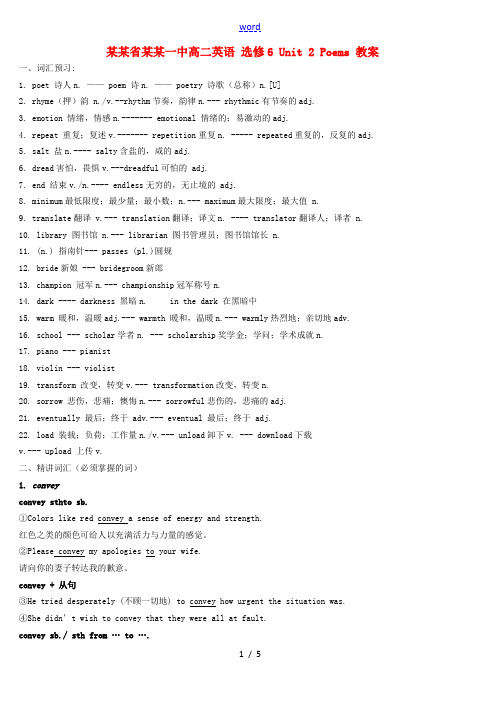
某某省某某一中高二英语选修6 Unit 2 Poems 教案一、词汇预习:1. poet 诗人n. —— poem 诗n. —— poetry 诗歌(总称)n.[U]2. rhyme(押)韵 n./v.--rhythm节奏,韵律n.--- rhythmic有节奏的adj.3. emotion 情绪,情感n.------- emotional 情绪的;易激动的adj.4. repeat 重复;复述v.------- repetition重复n. ----- repeated重复的,反复的adj.5. salt 盐n.---- salty含盐的,咸的adj.6. dread害怕,畏惧v.---dreadful可怕的 adj.7. end 结束v./n.---- endless无穷的,无止境的 adj.8. minimum最低限度;最少量;最小数;n.--- maximum最大限度;最大值 n.9. translate翻译 v.--- translation翻译;译文n. ---- translator翻译人;译者 n.10. library 图书馆 n.--- librarian 图书管理员;图书馆馆长 n.11. (n.) 指南针--- passes (pl.)圆规12. bride新娘 --- bridegroom新郎13. champion 冠军n.--- championship冠军称号n.14. dark ---- darkness 黑暗n. in the dark 在黑暗中15. warm 暖和,温暖adj.--- warmth 暖和,温暖n.--- warmly热烈地;亲切地adv.16. school --- scholar学者n. --- scholarship奖学金;学问;学术成就n.17. piano --- pianist18. violin --- violist19. transform 改变,转变v.--- transformation改变,转变n.20. sorrow 悲伤,悲痛;懊悔n.--- sorrowful悲伤的,悲痛的adj.21. eventually 最后;终于 adv.--- eventual 最后;终于 adj.22. load 装载;负荷;工作量n./v.--- unload卸下v. --- download下载v.--- upload 上传v.二、精讲词汇(必须掌握的词)1. conveyconvey sthto sb.①Colors like red convey a sense of energy and strength.红色之类的颜色可给人以充满活力与力量的感觉。
选修6Unit2Poems教学设计
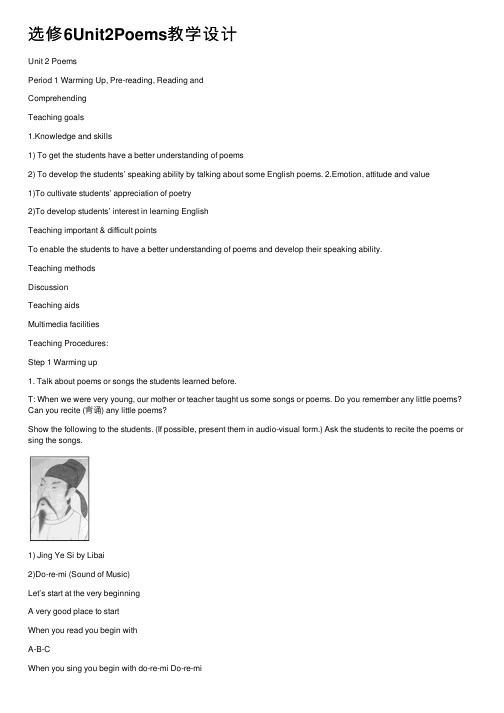
选修6Unit2Poems教学设计Unit 2 PoemsPeriod 1 Warming Up, Pre-reading, Reading andComprehendingTeaching goals1.Knowledge and skills1) To get the students have a better understanding of poems2) To develop the students’ speaking ability by talking about some English poems. 2.Emotion, attitude and value1)To cultivate students’ appreciation of poetry2)To develop students’ interest in learning EnglishTeaching important & difficult pointsTo enable the students to have a better understanding of poems and develop their speaking ability.Teaching methodsDiscussionTeaching aidsMultimedia facilitiesTeaching Procedures:Step 1 Warming up1. Talk about poems or songs the students learned before.T: When we were very young, our mother or teacher taught us some songs or poems. Do you remember any little poems? Can you recite (背诵) any little poems?Show the following to the students. (If possible, present them in audio-visual form.) Ask the students to recite the poems or sing the songs.1) Jing Ye Si by Libai2)Do-re-mi (Sound of Music)Let’s start at the very beginningA very good place to startWhen you read you begin withA-B-CWhen you sing you begin with do-re-mi Do-re-miDo-re-miThe first three notes just happen to be Do-re-miDo-re-miDo-re-mi-fa-so-la-tiOh, let’s see if I can make it easier Doe, a deer, a female deerRay, a drop of golden sunMe, a name I call myselfFar, a long long way to runSew, a needle pulling threadLa, a note to follow sewTea, I drink with jam and breadThat will bring us back to do ... oh oh oh Doe, a deer, a female deerRay, a drop of golden sunMe, a name I call myselfFar, a long long way to runSew, a needle pulling threadLa, a note to follow sewTea, I drink with jam and breadThat will bring us back to doDoe, a deer, a female deerRay, a drop of golden sunMe, a name I call myselfFar, a long long way to runSew, a needle pulling threadLa, a note to follow sewTea, I drink with jam and breadThat will bring us back to doDo re mi fa so la ti do, so do2.Talk about the characteristics of poems. Show the followingopinions to the students.Poems have beats. They may rhyme or may not rhyme —but they have to have rhythms. This beat is not always obvious, but it’s usually there.Rhyme and rhythm are essential to poetry. Without rhythm, there wouldn’t be poems. For example: Twinkle twinkle little star强弱强弱强弱强How I wonder what you are,Up above the world so highLike a diamond in the sky.3.Talk about why people write poems with the students.T: How many poets do you know?Have you read the two poems below?A Grain of SandBy William BlakeTo see a world in a grain of sand,And a heaven in a wild flower,Hold infinity in the palm of your hand,And eternity in an hour.DreamsBy L. HughesHold fast to dreamsFor if dreams dieLife is a broken-winged birdThat can never fly.Hold fast to dreamsFor when dreams goLife is a barren fieldFrozen only with snowT: There are many reasons why people write poems. Some want to pass on some information, some tell a story, some express feeling of love, anger, joy, etc. We’ve learned a lot of poems before, especially in Chinese. But what are the reasons why people write poems? Work in groups and list some.Sample answers:People write poems: to express one’s hopes and intentions; to call up people to do something; to practice writing; to pour out one’s feelings; to show dissatisfaction or praise ...Sum up: A poem is a composition with rhythmic balance expressing ideas or experiences or feelings.A poem is a literary work that is not in verse but deals with emotional or descriptive themes in a rhythmic form.A poem is a piece of writing in which the words are arranged in separate lines, often ending in rhyme, and are chosen for their sound and for the images and ideas they suggest.Step 2 Pre-reading1. Words preview:tick, rhyme, convey, nursery, concretr, contradictory, diamond, flexible, pattern, cottage, sparrow, tease, salty, endless, minimum, branch, translation, be made up of, run out of, on Particular, take it easy2. Please go over quickly the poems in the reading part. And then tick the correct box / boxes for each question.Sample answers:Step 3 Read the poems1.Listen to the poems in the reading part, paying attention to the pauses within eachsentence.2.Listen again and read after the tape.3.Share your feeling with the rest of the class.Step 4 Homework1.Recite one of your favourite poems from the passage.2. Ask the students to collect English poems.Period 2 ReadingTeaching goals1.Knowledge and skills1)To know the meanings of the following new words and phrases:tick, rhyme, convey, nursery, concretr, contradictory, diamond, flexible, pattern, cottage, sparrow, tease, salty, endless, minimum, branch, translation, be made up of, run out of, on Particular, take it easy.2)To learn about some simple forms of English poems.3)To develop the students’ reading ability by skimming and scanning the passage.2.Emotion, attitude and value1)To cultivate students’ appreciation of poetry and the ability of understanding, enjoying poems.2)To develop students’ sense of cooperative learning.Teaching important & difficult pointsTo enable the students to learn about some simple forms of English poetry and develop their reading ability. Teaching methodsDiscussion & Task-based teaching& learningTeaching aidsMultimedia facilitiesTeaching Procedures:Step 1 Leading-in1.Ask some students to read their favorite poems in front of the class.2. Words preview:tick, rhyme, convey, nursery, concretr, contradictory, diamond, flexible, pattern, cottage, sparrow, tease, salty, endless, minimum, branch, translation, be made up of, run out of, on Particular, take it easyStep 2 Reading1.Skimming1) Skim the text and get the main idea of the text.(Suggested answer: A birfe introduction of a few simple forms of English poems.)2) complete the table below.Then make a diagram to show the meaning and organization of the text2.Scanning3.Detailed-reading1)①What’s the main idea of Poem A? ②Find the strong rhythrm and rhyme in it.(Suggested answer: A is a nursery rhyme that illustrates a father’s love for his baby.)2)①What are the main idea of Poem B and C?②What’s the differences between themthough they are both list poems?(Suggested answer: B is an amusing nonsense poem which describes images of some ridiculous things.Poem C is about losing a football match and the writer lists a lot of excuses for their failure.) 3)①What are the main idea of Poem D and E?②A brife introduction of the structureof the cinquain.(Suggested answer: Poem D is a description of a lovely brother.Poem D is a description of hot and boring summer.)The structure of the cinquain:Line 1: a noun that names the subject of the poemLine 2: two adjectives that describe the subjectLine 3: three verbs ending with –ing that describe the subject’s actionsLine 4: four words that give the writer's opinions or feelings about the subjectLine 5: a word that gives another name for the subject4)①What are the main idea of Poem F and G?②Can you find out the 17 syllables inthem?(Suggested answer: Poem F describes how a butterfly rests on a tree.Poem G describes that the weather is warmer and the village is full of happy children.5)①What’s the main idea of Poem H?②What feelings do you think the woman has? ③Can you give a proper title to Poem H either in English of Chinese?(Suggested answer: ①A woman’s husband has gone away. The woman waits for him by the river where she last saw him. She waits and waits, never moving from that spot and never speaking, while the river continues to flow and the wind and rain come and go.②Loneliness: she was alone watching her husband on the mountain top.Love: she waited year after year despite wind and rain.Trust: she believed her husband would come back one day.Sorrow: year after year, she waited and waited without seeing any hope of her husband’s coming back, she was very sad.③望夫⽯/ A Loyal WifeThe Chinese version of poem H:望夫⽯王建望夫处,江悠悠,化为⽯,不回头。
英语:unit 2《poems》教案-writing(新人教版选修6)
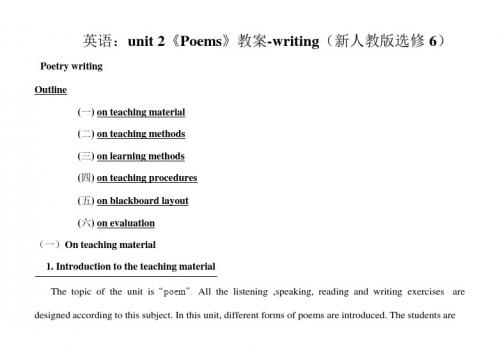
4.
Teaching important points
① Get thestudents to appreciate English poems. ② Guide thestudents to writepoems step by step. ③ Improvethe students’writing ability.
(四)On teaching procedures
Teaching steps
Teacher’s activity
Students’activity
Designing purpose
1. Lead-in
Show the students two Read the two poems and Get the students to poems try to discover the features. discover the features themselves so that it will be easier for them to write.
This lesson focuses on poetry writing so that students can learn to appreciate and write poems after learning someforms of 3. Teaching goals poems. Therefore, students’ability of using language can be fully impr
Check students’ work and give guidance Tell the features
Get the students to
review the features
人教版高二英语选修6教案UNIT2POEMSPERIOD6
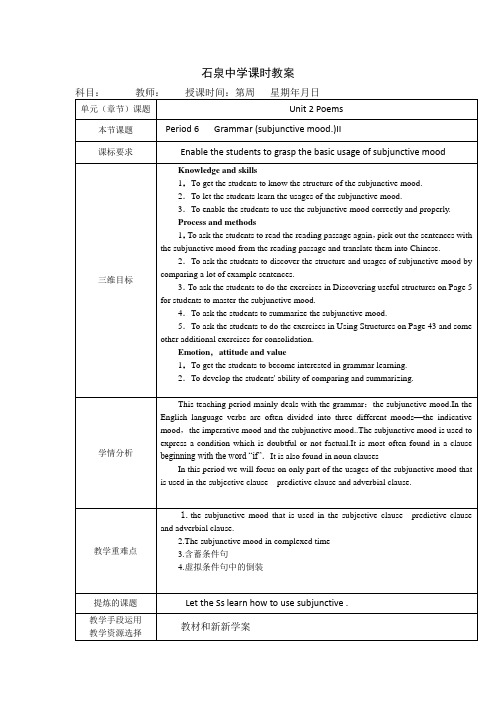
Guide students to finish the
Practice
grammar exercises in Learning
2. Show them the correct answers.
Self-learning
1.Instruct Ss to learn the grammar item in Unit2 1).错综时间条
件句的虚拟语气 2).含蓄条件句中的虚拟语 气 3).虚拟条件句中的倒装
Guidance
.Help Ss summarize the grammar rules .
学情分析
This teaching period mainly deals with the grammar:the subjunctive mood.In the English language verbs are often divided into three different moods—the indicative mood,the imperative mood and the subjunctive mood..The subjunctive mood is used to express a condition which is doubtful or not factual.It is most often found in a clause beginning with the word “if”.It is also found in noun clauses
- 1、下载文档前请自行甄别文档内容的完整性,平台不提供额外的编辑、内容补充、找答案等附加服务。
- 2、"仅部分预览"的文档,不可在线预览部分如存在完整性等问题,可反馈申请退款(可完整预览的文档不适用该条件!)。
- 3、如文档侵犯您的权益,请联系客服反馈,我们会尽快为您处理(人工客服工作时间:9:00-18:30)。
高二上学期第七次教案设计人:Unit 2 Poems 选修6IV.教学步骤:Period 1 Warming up, Pre-reading, Reading (1)Teaching Goals:1. To arouse Ss’ interest in learning about English poems.2. To develop Ss’ ability of comparison.3. To arouse Ss’ interest in learning about different types of poems in the world.4. To develop some basic reading skills.Teaching Procedures:Step 1 Leading-inPurpose: To activate Ss and arouse them to talk about their own little poems.Show the poem written by Wang Zhihuan and a photograph of the writer. Ask Ss to read the poem and. And see if they can remember any poems that they have learnt, either in Chinese or in English, and then ask them to recite one of them.Step 2: Warming UpPurpose: To lead Ss to the topic of this unit through a discussion.1. Pair workGet Ss to ask their partners the questions, and then ask them to present it before the class.(1) Which poem is written to tell a story?(2) Which poem is written to express feelings?(3) Which poem is written to make other laugh?…2. Group workGet Ss to talk about the world famous poets. The pictures below can be used for Ss to talk about, and Ss can also talk as much as they can.William Shakespeare George Gordon Byron Li Bai威廉·莎士比亚乔治·戈登·拜伦李白Conclusion: All these poets are well known to the whole world and do you know any poems written by them? Can you recite to all the class?Step 3. Pre-readingPurpose: To help Ss learn about the context of the Reading part.1. Group workAsk Ss to discuss the questions with their partners in groups of four.(1) Do you have a favorite poem in Chinese?(2) Why is it your favorite poem?(3) Do you have a favorite poem in English?(4) Why is it your favorite poem?For example:(1) My favorite poem in Chinese is: 去年今日此门中,人面桃花相映红。
人面不知何处去,桃花依旧笑春风。
---- 崔护〈〈题都城南庄〉〉The reason why I like the poem better than any poem is that I like the atmosphere the poem created for readers: though the people we knew have gone away, the peach blossoms are still there smiling in the spring wind.(2) My favorite poem in English is: A Grain of Sand 一粒沙子---William Blake 威廉.布莱克The reason why I like the poem better than any poem is that from the poem I have gained a lot, that is, we can get something valuable from even tiny things and we can achieve what we want if we can master what we have had now. It’s my power to advance when I feel depressed.2. Individual workGet Ss to complete this questionnaire individually after reading the following poems in the Reading Text.Step 4. Reading (1)1. SkimmingPurpose: To get a brief understanding of the text.(1) Ask Ss if they are curious about some English poems. Do they want to appreciate some kind of poems? And get the some Ss to answer this question.(2)Read through the text, preferably the paragraphs beside the seven poems and then decide which poem you like best? Give reasons.(3) Try to answer the questions about the passage.①What is the main topic of the reading passage?②What five kinds of poems does the reading passage talk about?Suggested Answers:①: The main topic of the reading passage is about some simple forms of English poems.②: The five kinds of poems that the reading passage talks about are: nursery rhymes, list poems, the cinquain, haiku and Tang poems.Step 5. Homework1.Read the text fluently and then prepare for the following questions on your textbook.2.Get on the line and find out more beautiful poems.Period 2 Reading (2), Comprehending, Reading task (Workbook)Teaching Goals: 1. To learn about the characteristics of five simple forms of English poems.2. To develop some basic reading skills.3. To arouse Ss’ interest in appreciating English poems.Teaching Procedures:Step 1. ReadingPurpose: To get Ss to get some details in the text.1. Scanning(1) Read the text carefully and try to get some details from the text. Work in pairs and try toask and answer questions from the text. Questions can be like these.①There are two poems that have a strong rhythm. Which ones are they?②Which two poems have rhyming lines? Circle the pairs of rhyming words.③Which poems give you one clear picture in your mind?2. Listen to the tape and deal with the language points in groups.(1) Listen to the tape and follow it in a low voice.(2) Group workSs are divided into five groups. Each group is supposed to read through each part, and then discuss them.Part 1①recite v 背诵. He can recite that poem from memory.②rhythm n 韵律;节奏The exciting rhythms of African drum music make us feel good.③repetition n. 重复;循环;复制品;副本I want no repetition of your bad behavior. 我不希望你重做你干的坏事。
